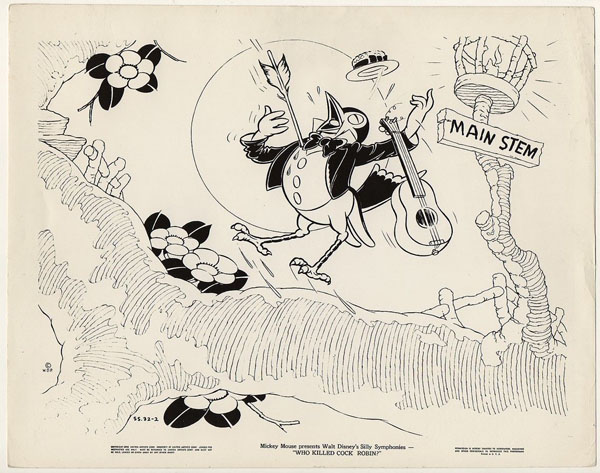
I suppose that one cannot blame the music department of the Walt Disney studios for hoping that another fortuitous stroke of lightning would hit in the same place.
Their 1934 songs–including “The World Owes Me A Living”, “You’re Nothing But A Nothing” and “Peculiar Penguins”–had not made the cash registers ring to the same degree as has “Who’s Afraid Of The Big Bad Wolf?”.
But that wasn’t because the Disney people weren’t trying!
 For 1935, the music department was pinning its hopes on a song which went with a cartoon that was based on a poem that had first been printed around 1744–and may have existed in oral tradition before then.
For 1935, the music department was pinning its hopes on a song which went with a cartoon that was based on a poem that had first been printed around 1744–and may have existed in oral tradition before then.
The cartoon–and the song–was Who Killed Cock Robin?
As far as I know, there were no commercial recordings made of the song. There may well have been sheet music. But it does exist–a twenty-four bar verse and a full thirty-two bar chorus. It exists in the form of an “air-check”–a recording made from a live broadcast.
Ben Bernie had been leading a popular dace- and stage-band for some thirteen years–seven of which at the Grill Room of the Roosevelt Hotel in midtown Manhattan. (Bernie’s replacement at that venue was Guy Lombardo.) By the middle 1930’s, he was spending much of his time in Chicago, playing at such venues as the College Inn at the Hotel Sherman, and doing three years worth of weekly broadcasts over NBC’s Red Network, sponsored by Pabst—first pushing heir malt syrup, then pushing their beer after Prohibition had ended.
 The program of August 17th, 1935 has circulated among collectors for more than forty years, since it was issued on LP by George Garabedian’s Mark 56 label, in a series of LPs devoted to old-time radio programs. And it was on that broadcast that Ben Bernie featured “Who Killed Cock Robin?”.
The program of August 17th, 1935 has circulated among collectors for more than forty years, since it was issued on LP by George Garabedian’s Mark 56 label, in a series of LPs devoted to old-time radio programs. And it was on that broadcast that Ben Bernie featured “Who Killed Cock Robin?”.
The cartoon had been in theaters for just under two months. And it was as successful as any “Silly Symphonies” cartoon was then–meaning that it was quite successful indeed. The cartoon was noted in its time for the lively and lifelike impression of Mae West, her portrayed as the buxom Jenny Wren. The song itself s only heard briefly–eight bars and a tag–over the cartoon’s actual title.
Bernie gives it the real stage-band treatment, displaying the personality that made him a star big enough for cartoon studios to caricature–which they did! Bernie talk-sings the lyric, in the manner that was so easily parodied by amateur impressionists. He also features a good deal of patter, or “special material”, which he distributes among several band members. Various band members get their licks in, vocally. These include Manny Prager (saxophonist, who also sang novelties), Billy Wilson (who usually sang uptempo songs), Dick Stabile (who did not usually sing, but was considered a saxophonist’s saxophonist),and Ray Hendricks (romantic tenor).
Bernie even gets in a dig at Walter Winchell. Their “feud” is going to be a subject of a future Post in this column.
After this, the Disney people appear to have given up on trying to get popular song hits out of their short subjects. But when it came time to put out a full-length feature film. . . Aaaaaah!

Next: Another Mouse Melody. . . and an interloping duck.


 James Parten has overcome a congenital visual disability to be acknowledged as an expert on the early history of recorded sound. He has a Broadcasting Certificate (Radio Option) from Los Angeles Valley College, class of 1999. He has also been a fan of animated cartoons since childhood.
James Parten has overcome a congenital visual disability to be acknowledged as an expert on the early history of recorded sound. He has a Broadcasting Certificate (Radio Option) from Los Angeles Valley College, class of 1999. He has also been a fan of animated cartoons since childhood.











































I’m confused. Maybe I’m misreading this. But if there were no commercial recordings of the song, what is the record depicted in the image? It’s not the Ben Bernie; it’s an official Disney 78, no — probably from Britain, given the label? And moreover, it’s Part 2 of the song. Yet it says it comes from the actual film. That would equal about six minutes of the song “Who Killed Cock Robin?” This doesn’t seem to square at all with your statement that “The song itself s only heard briefly–eight bars and a tag–over the cartoon’s actual title.” Please explain! Thanks…
It isn’t the song – it’s the actual audio from the cartoon. HMV (and Bluebird in the USA) released a whole series of these soundtracks.
Keep “tooned” in to this column.
“Who Killed Cock Robin?” is shown in a cinema in Alfred Hitchcock’s “Sabotage” (1936) as a major plot device.